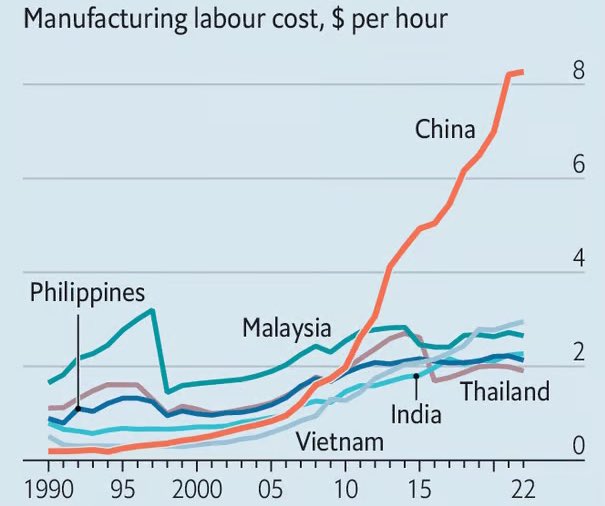Taps Coogan – January 17th, 2024
Enjoy The Sounding Line? Click here to subscribe for free.
While the trade wars have taken a back seat to other economic and geopolitical drivers over the past four years, the looming US presidential election promises to return the issue to the spotlight. Within that context, the following chart via Michael Arouet highlights the deteriorating competitive position of China for low-cost labor.
Geopolitics is just one reason why foreign investors prefer other countries over China. It’s simply much cheaper to invest somewhere else. pic.twitter.com/4REtrsXKbz
— Michael A. Arouet (@MichaelAArouet) January 15, 2024

If you are looking to set up low labor-cost manufacturing in 2024, China is not competitive. Add in the real risk of sanctions or war over Taiwan or some rock in the South China Sea and, not surprisingly, foreign direct investment in China hit near-zero in 2023.
All that being said, labor costs have never been as important to manufacturing dominance as widely believed. As we noted years ago, when US manufacturing dominance started emerging in the 1930s, wages in the US were just as high relative to the next largest industrial nations of that era as they are relative to China today. The key to industrial dominance is competitive trade, regulatory, and tax policy and the US has, with every few expansions, neglected to prioritize competitiveness in those domains for decades.
Companies will build production capacity in a country where that production can be shipped tariff-free to the largest markets (which requires reciprocal low tariffs – not just the US extending low tariffs to others in exchange for nothing), where factories can be built quickly, where there is not the fear of constantly shifting regulatory requirements, where taxes are competitive, and where there are existing supply chains and abundant skilled labor. The US scores poorly on virtually all these fronts.
Would you like to be notified when we publish a new article on The Sounding Line? Click here to subscribe for free.


So two factors are also important
1) output per worker which depends on manufacturing output capacity and machinery utilized at optimim capacity
2) Trade Ssanctions. Unfortulately we are entering a period of trade sanctions which distort comparative advantage and lead to Hot Wars. U.S. is headed in wrong direction in Far East and with Russia/Europe.